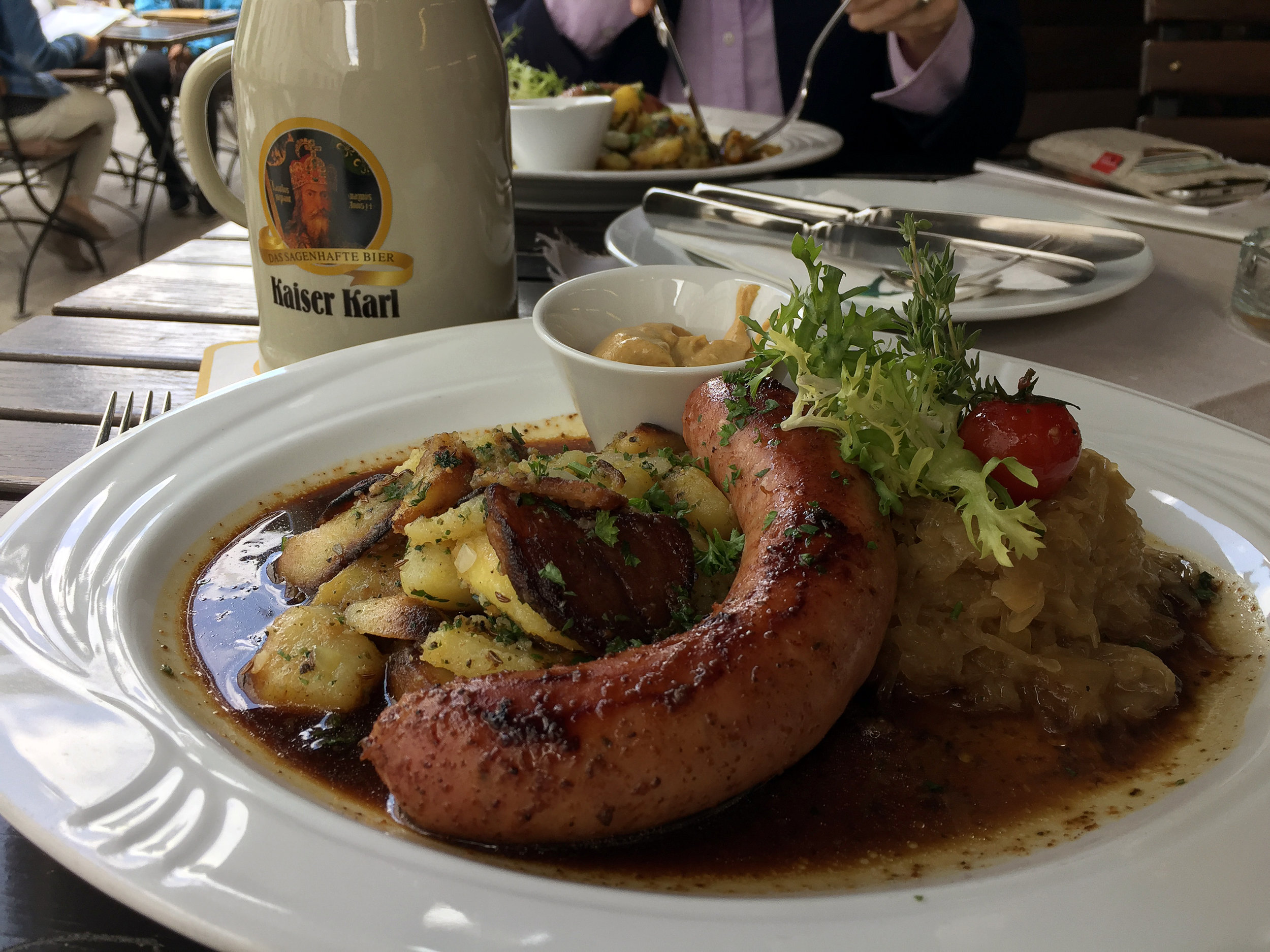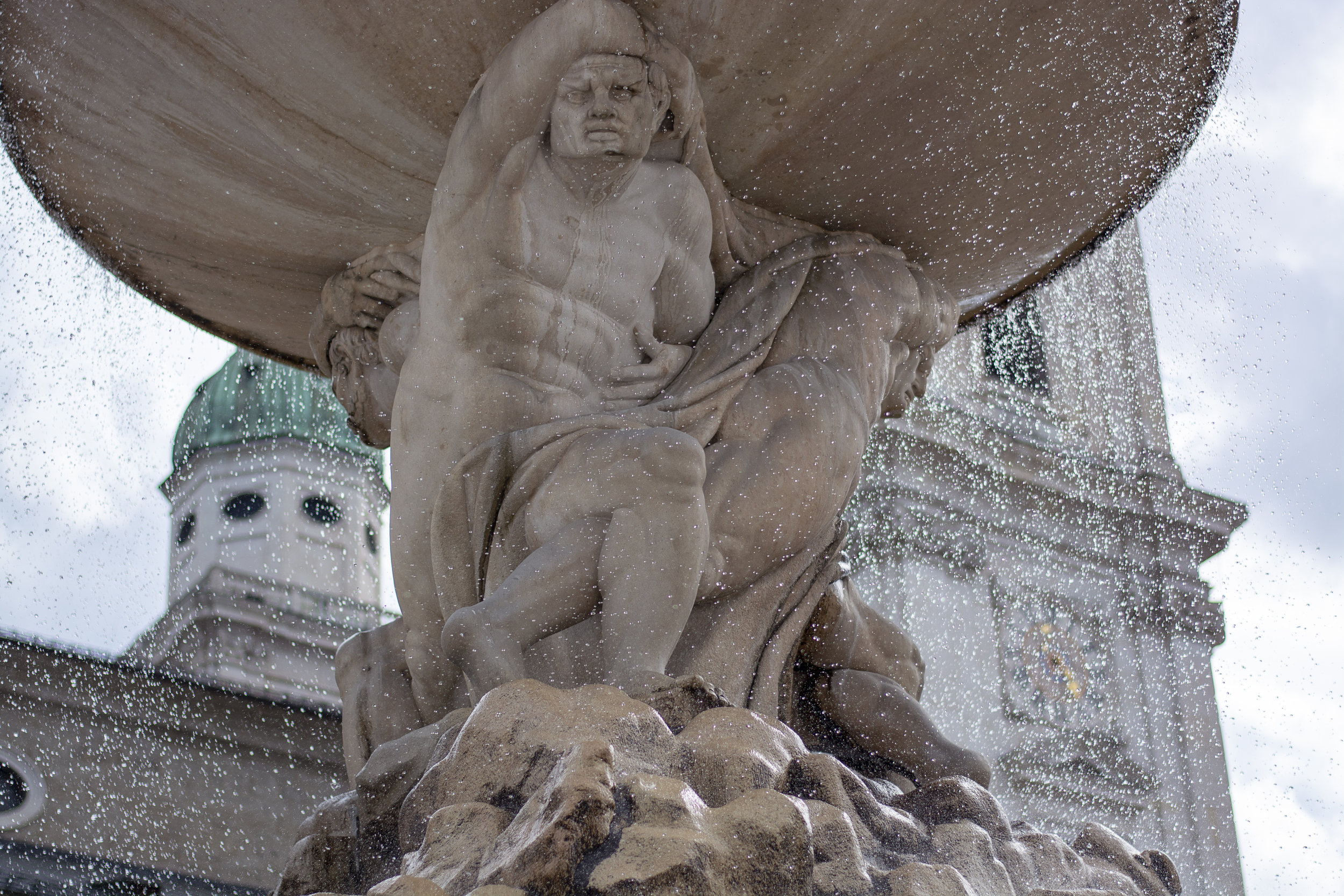Click here for Part I.
JUNE 2018 — A group of eight assembled for my mother’s reminiscence trip: her two adult children came with their spouses, plus two young nieces (10 and 6) and her son-in-law’s mother, who had never been to Europe. While there were benefits to traveling in groups, inevitably there would be occasional miscommunications in our native tongue, differences of opinion, conflicting paces, and an indecisive herd mentality.
Evening church bells rang, right out of the opening sequence of the “Sound of Music”, reverberating within the quaint city streets as we set out in search of a place to eat. We settled at the curiously named Zum fidelen Affen (“The Jolly Monkey”), with outdoor seating on the pedestrian-only Priesterhausgaße, a narrow plaza beneath the prominent cliffs of Kapuzinerberg. My sister’s family was more than happy to return to the same place they ate the night before. The girls had specific dietary restrictions that this happy primate could accommodate, along with delicious regional fare for everyone else, including wiener schnitzel and goulash. Although it was the peak of summer, the air was unexpectedly chilly and we were grateful for the restaurant-provided blankets. No one properly packed for such a cold spell, yet the hot-blooded girls were undeterred in their shorts. To entertain themselves, they played nearby in small fountain that sent plastic balls surfing downhill.
Von Trappist monkey
It was a pleasant start to the adventure, a hypothetical finally becoming a reality, and the relaxation of vacation. Salzburg was no longer an abstract image in my mind, a picture in a book or a scene from a movie, but a real place to experience and absorb.
An unbelievable breakfast buffet awaited us in the hotel’s sunny dining room—an enticing spread of fresh fruits, meats, müseli, breads, hard boiled eggs, and juices, plus espresso drinks to energize jet-lagged guests. It was one of those meals you never want to end, the coffee so good, the tables full of so many things to eat. The rolling arrival of our group allowed time to enjoy the endless meal while my sister and her husband picked up their rental car.
We hit the road maybe too late for the day’s big destination, a visit to the salt mines that gave Salzburg its name (literally “salt mountain”) with tickets for a timed entry. With Mozart and Haydn on the stereo, the drive gave me and Katherine a chance to see central Salzburg before embarking on a gorgeous country drive to Berchtesgaden, on the German side of the salt mountain. I nearly missed the turn for the mine, then had a hard time finding parking at the popular destination, especially amongst impenetrable tour buses and tourists meandering like zombies.
My sister, who took her time at breakfast, now rushed us to enter at our allotted time. We put on thick, navy blue boiler suits to protect our clothes and stuffed bags and cameras in little lockers. Our group of eight boarded a little electric train, straddling the padded seats and pausing for a photo before descending into the caverns. The spiffy tour guide spoke only in German, but we were given mobile phones to press against our ears for a pre-recorded version in English. The salzbergwerk was fascinating, vast, and well maintained. The tunnels were carved into a giant slab of prehistoric sea salt that was buried in a series of geological events. Humans have been mining the place as far back as the 12th century, and despite the aid of modern machinery and a global appetite for salt, only a fraction of the massive salt bed has been harvested.
Watch your salt intake.
Another party joined us on the tour, a small group of crude tourists of unknown European origins (I believe they spoke German). One kept taking flash photos despite repeated warnings. As we overlooked the first salt chamber, the lights turned off and one of them coughed nervously and clutched my arm. She was a tall young woman who seemed to possess some nervous tick. Despite her odd behavior, I felt bad for her as her companions paid her little attention.
In the first big chamber, a light show explained how the water-filled crevices dried out, leaving saline behind. This preceded the biggest highlight of the tour: a large wooden slide designed to allow miners to quickly descend. We slid down like a bobsled team, four at a time, straddling the very polished “track” with a steep, 34-meter drop, perfectly engineered to slow our force at the end. The plunge included an official photo op. Further on, there was a longer slide followed by a boat ride across a silvery underground lake, complete with three-dimensional light show, plus a scale model of the entire place, showing the angular tendrils bored into the salt bed and a visual explanation of how water flushes out the salt as brine. Ninety minutes after we descended into darkness, the train brought us back to daylight. We ditched our jumpsuits and raided the gift shop for salty souvenirs.
Our group split at the end of the tour. The Chicago crew planned to venture into Berchtesgaden for lunch, but Katherine and I wanted to see Salzburg—it was our only full day there. We also had ulterior motives: the urgent need to resolve some packing errors. So the other car was crowded with one too many people while my wife and I went comfortably on our way.
The last place any international traveler wants to see is a mall, but when time is short and needs are many, sacrifices must be made. The expansive Europark on the outskirts of Salzburg was an emporium of salvation. Katherine forgot to pack jeans, and there was a Levis store. My travel charger blew out on the first use, and there was an electronics store. We needed sunscreen, toothpaste and shampoo, and there was a grocery store. Even Lee forgot her iPhone charger, and there was an Apple store. It was interesting to observe mall culture in a foreign land—there is little difference. A bi-level promenade lined with hundreds of stores, meandering shoppers, trend-hungry teens, skylights, a sprinkle of fountains and vegetation, and pleasant wafts of fast food. If the Europark had any improvement to its average American counterpart, it was the sprawling underground parking lot with digital counters to help drivers find open spaces, even if the spaces were narrow and a challenge to get in and out of, plus a rail station for those who didn’t drive at all.
Ausfahrt means exit.
Mission accomplished, we were free to explore Salzburg. Katherine and I walked into the center of the city, crossing the Salzach River into “old town”, exploring pristine streets, taking photos, buying souvenirs, and ultimately choosing lunch instead of a steep ascent to the castle that towered over the city, the thousand-year-old Hohensalzburg Fortress. It was surprisingly difficult to find a restaurant that served Austrian food, but we persevered and found a fantastic place for bratwurst and sauerkraut with delicious beer to wash it down. We sat outside in the breeze as horse-drawn carriages trotted by and finally, we relaxed.
Vienna may be famous as the glistening epicenter of Austria, but Salzburg felt like the heart of the oddly-shaped nation. Thanks to popular culture, its chief reputation is as the setting of the true-story musical (and movie) “The Sound of Music”, although its true musical claim is being the hometown of legendary composer Wolfgang Amadeus Mozart. The city remained as timeless as his music—vibrant with life, colorful old buildings and romanticism.
Sightseeing is often better with a full belly and a beer buzz. Katherine and I declined the castle a second time and wandered old town instead, down to Herbert von Karajan Platz and back through the gawkers crowded outside Mozart’s birthplace, down corridors lined with decorative signage sticking out of their facades. The prominent hill on the north side of the river appealed to us more than the castle mount, so we searched narrow and quiet Steingasse in search of a stairwell, but had to double back and ultimately found a hidden entrance near Zum fidelen Affen. We easily ascended the Kapuzinerberg and overlooked the city, peaceful in the early evening, as a chorus of church bells began to ring.
The fountains of Residenzplatz.
Refreshed back at the hotel and savoring some mojitos in the bar, the group reassembled and exchanged accounts of our separate adventures. After Berchtesgaden, the Chicago crew explored Schloss Hellbrunn, a luxurious Baroque palace with sprawling gardens on the outskirts of Salzburg particularly known for its trick fountains. My mother had distinct memories of playing in them when she was a kid; watching her nieces get gleefully drenched by the “water games” was the first of many links between her past and present.
The hotel’s recommendation for dinner was crowded with locals in anticipation of Germany’s World Cup match against Sweden, with cigarettes fouling the air inside and out. We wandered back towards the center of town as the sky grew dark. Nothing looked appealing and no one could come to an agreement. Restaurants were shuttering in touristy old town. Those that were open were packed with crowds huddled near big screen TVs. Moods were souring, patience was wearing thin, but at the last moment, we found an outdoor beer garden with open tables. The ambience was nice and the no-frills menu was sufficient. Everyone ordered bratwurst with sauerkraut on the side. Our uniformity humored the waitress, who dazzled us clenching multiple beer steins in each hand. The World Cup was in earshot enough to hear gasps and cheers for every shot on goal. It turned out the Austrians were rooting against Germany, a curious insight into Austria’s relationship with its northern neighbor.
The walk back was much more pleasant. Crowds trickled out of bars, jubilant despite the Germans’ triumph over the Swedes. We crossed the locket-covered Makartsteg footbridge, reminiscent of the similarly adorned Pont des Artes in Paris. My eldest niece, Stella, was especially intrigued by the sight of thousands of colorful locks attached to the rails by anonymous couples expressing their permanent commitment. It was easy to fall in love with Salzburg, but we would not be locking ourselves to it. The waters of the Salzach would continue onto the Danube, while new adventures awaited us in Innsbruck.
[More photos can be seen on my Flickr site.]








